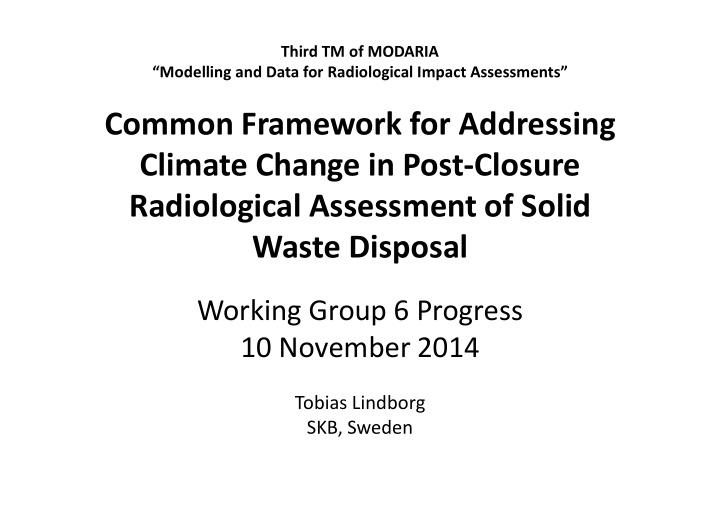



Third TM of MODARIA “Modelling and Data for Radiological Impact Assessments” Common Framework for Addressing Climate Change in Post-Closure Radiological Assessment of Solid Waste Disposal Working Group 6 Progress 10 November 2014 Tobias Lindborg SKB, Sweden
WG6 Objectives � Define key processes driving environmental change (mainly climate change) and describe how a relevant future may develop on a global scale. � These drivers are quantitative and can be extracted from scientific consensus on historical climate evolution. � Results can be used to describe the future environments, which we call ‘reference futures’ and/or ‘future variants’. � Not predictions but relevant examples that provide valuable input for solving specific questions in a safety assessment. � Develop methodology (conceptual framework) that is valid on a global scale, and consider how that can be downscaled to for site specific assessments. � Apply the framework to case studies to illustrate the evolution of site characteristics and the implications for the dose assessment models, including the justification of abstraction into simplified assessment level models.
WG6 Approach to the Work Building on national R and D programmes, supported by post-graduate studies, interfacing with research institutes Practical relevance to realistic types of repositories New climate model calculations: � Up to 1000 years � Beyond 1000 years Update and illustrate downscaling methods Investigation of Site Narratives for Climate Change using Complex, Simple and Intermediate Models
Interim meeting at Bristol University, UK • Climate considerations in long-term safety assessments for nuclear waste repositories (Jenny Brandefelt, SKB) • Atmospheric lifetime of anthropogenic CO 2 emissions (Natalie Lord, University of Bristol) • Addressing Environmental Changes in the Campine Area (Lieve Sweeck, SCK-CEN) • Evaluating Process Understanding and Determining Confidence (Shulan Xu, SSM) • Climate Change in Updated Biosphere Assessment of the Facilities at El Cabril (Danyl Pérez-Sánchez, CIEMAT) • Water balance and hydrological interactions between catchment, lake and talik in a periglacial landscape (Emma Johansson, SKB) • Ice-sheet Modelling/Sea-level Change (Tony Payne, Univ. of Bristol) • Regional Modelling of the Potential for Permafrost Development in Great Britain Permafrost Influences (Simon Norris, RWM) • Simple and Complex Biosphere Models (Russell Walke, Quintessa) • GEMA-Site (Ryk Klos, Alexandria Sciences)
Wide range of relevant categories of facility considered Mode of Geological Hydrogeological Coastal Potential for Construction Context Context Context Climate Extremes Crystalline Excavated from Saturated Inland Glaciated surface Clay Unsaturated Coastal Non-glaciated Excavated at Consolidated Sedimentary depth other than clay Submerged Periglacial Unconsolidated sedimentary Salt Volcanic tuff Metamorphic Mixed
Consultation 1a) Definition of a conceptual model with of system (through use of 1) Identification of disposal systems interested using the standard typography FEPs/Interaction parties (e.g. Matrices/Geometrical models) design 2) Definition of emissions scenarios department, 3a) Palaeoclimatic national inputs authorities) Climate 3 ) Identification of climate models modelling and model outputs (EMICs/AOGCMs/RCMs/ESMs) 4) Specification and running of climate models Downscaling 5 ) Climate domains and climate 6) Landscape properties at present narratives at a regional or local scale day 7) Project landscape properties over 6a) Site characterization assessment timescale using climate narratives and data 8) Illustrate with specific examples, that may be broadly applicable, but with a requirement to state limits Implications 9) Qualitative and quantitative evaluation of for impact, the illustrative examples with an emphasis on their applicability confidence on the uncertainties associated to future building climates
Site specific examples Forsmark Weichselian glacial cycle Forsmark, Sweden Climate development in time Maximum ice sheet thickness c. 2900 m Maximum permafrost depth c. 260 m
Site understanding alternatives, to investigate: how does climate change effect assessed impacts? …and how much ”complexity” is useful? High site understanding No site understanding Complex site specific model Less complex alternative Reference Biosphere model models agricultural land well lake wetland
Updated WG6 Report Outline (tentative) � Background, Objectives and Scope � Approach to define relevant framework � Typography of Facility Types � Controls on Long Term Climate Change � Representing the Climate System � Palaeo Reconstructions � Prognosis of Future Climate � Global � Regional Downscaling � Development of climate and landscape change narratives for specific sites or regions � Illustrative Application to Real Locations � Implications for Radiological Assessment Modelling � Analysing Process Understanding and Confidence � Discussion and Conclusions
Participation/practical interest � ONDRAF/NIRAS, Belgium � NUMO, Japan � BelV, Belgium � NIRS, Japan � CIEMAT, Spain � SCK-CEN, Belgium � SKB, Sweden � FANC, Belgium � SSM, Sweden � GRS, Germany � NAGRA, Switzerland � HMGU, Germany � NDA (RWMD), UK � POSIVA, Finland � ANDRA, France Links to WG3 and other WG � JAEA, Japan where interest is a few decades or longer
This week 1. Further sharing of experience in relevant national projects 2. Further development of WG6 methodology and example applications 3. Further consideration of implications for radiological assessment and confidence building 4. Planning for completion of WG6 activities and report
Recommend
More recommend